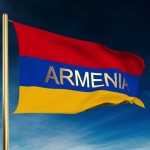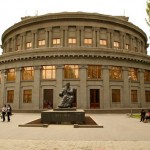
Western Armenia
Comment are off
Western Armenia is the territory to the west of today’s Republic of Armenia which was depopulated of Armenians during and after World War I by the Ottoman Empire and Turkey in the well documented Armenian Genocide. The boundaries can either be the six eastern vilayets, plus Kars, Ardahan and Igdir, or it can alternatively be Wilsonian Armenia, the borders of which were drawn by President Wilson as required by the Treaty of Sevres (never ratified) and the League of Nations.
BRIEF HISTORY
Western Armenia fell under the control of the Ottoman Empire about 600 years ago, while Eastern Armenia was held by the Persian, then Russian Empire. The political boundary, mountains and distance contributed to the development of two major dialects (Eastern and Western). By the 2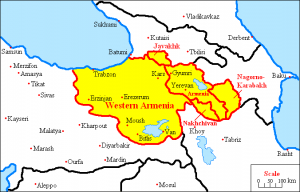 0th century, two major centers of Armenian culture had developed, Constantinople (Istanbul) for Western Armenians, and Tiflis (Tbilisi) for Eastern Armenians. Some Diaspora communities and institutions were very active as well – primarily in Venice, Jerusalem, Isfahan and India (Madras and Calcutta). After WWI, the center of Western Armenian life shifted to Beirut, then Los Angeles, while that of Eastern Armenians shifted to Yerevan. The six vilayets (provinces) of Western Armenia included Erzurum, Van, Bitlis, Diyarbekir, Kharput, and Sivas before the Armenian Genocide. Wilsonian Armenia had different borders, leaving out some of the areas to the south and west, but adding a long coast on the Black Sea (Trebizond, Rize, Hopa)
0th century, two major centers of Armenian culture had developed, Constantinople (Istanbul) for Western Armenians, and Tiflis (Tbilisi) for Eastern Armenians. Some Diaspora communities and institutions were very active as well – primarily in Venice, Jerusalem, Isfahan and India (Madras and Calcutta). After WWI, the center of Western Armenian life shifted to Beirut, then Los Angeles, while that of Eastern Armenians shifted to Yerevan. The six vilayets (provinces) of Western Armenia included Erzurum, Van, Bitlis, Diyarbekir, Kharput, and Sivas before the Armenian Genocide. Wilsonian Armenia had different borders, leaving out some of the areas to the south and west, but adding a long coast on the Black Sea (Trebizond, Rize, Hopa)
VAN
The city of Van is located near the SE corner o f the large salty Lake Van. The modern city, built near, but not over the old one is not remarkable, and the old destroyed Armenian sections were left to melt away with time. The old Van Fortress still stands. The Armenians defended themselves against Turkish troops for 5 weeks before the Russians arrived in May, 1915. The Russians left 6 weeks later, with many Armenians choosing to leave with them, and settle in the East.
f the large salty Lake Van. The modern city, built near, but not over the old one is not remarkable, and the old destroyed Armenian sections were left to melt away with time. The old Van Fortress still stands. The Armenians defended themselves against Turkish troops for 5 weeks before the Russians arrived in May, 1915. The Russians left 6 weeks later, with many Armenians choosing to leave with them, and settle in the East.
AGHTAMAR
By far the greatest highlight of this area is Aghtamar (Akhtamar) Island, with its monastery visible from the shore. Armenian monastery relatively well preserved. You must park at the foot of the hill and hike up the steep hill to reach the monastery with sweeping views.
VARAGAVANK
About 10km east of the town of Van are the remains of the once huge complex of Varagavank Monastery , known by locals as Yedi Kilise or Yedikilise (Seven Churches), reflecting its past glory. The ruins 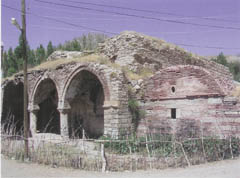 are still worthy of a visit. A few churches of the monastery remain in various states of collapse, two without roofs, one with frescoes, and some nice carved crosses, particularly along the front under the arches. Once the best known monastery of Vaspurakan and seat of the Archbishop of Van, the monastery takes its name from Mt. Varag (now Erek Dagi), whose southern slopes it rests on. The monastery was destroyed by the Turkish army on April 30th 1915, during the siege of Van. The village of Khorkom, is where Vostanik Atoyan was born. He escaped to the US during the genocide and changed his name to Arshile Gorky. He committed suicide in 1948.
are still worthy of a visit. A few churches of the monastery remain in various states of collapse, two without roofs, one with frescoes, and some nice carved crosses, particularly along the front under the arches. Once the best known monastery of Vaspurakan and seat of the Archbishop of Van, the monastery takes its name from Mt. Varag (now Erek Dagi), whose southern slopes it rests on. The monastery was destroyed by the Turkish army on April 30th 1915, during the siege of Van. The village of Khorkom, is where Vostanik Atoyan was born. He escaped to the US during the genocide and changed his name to Arshile Gorky. He committed suicide in 1948.
WEST OF VAN
To the west of Lake Van, the town of Mush lies in the Taron region, surrounded by fortified monasteries. The monasteries of Surb 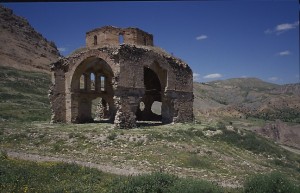 Arakelots and Surb Karapet are the most important. Surb Arakelots was defended by General Antranig in 1901, and Surb Karapet is where Khrimian Hairig published the “Eagle of Taron” newspaper in 1863, later on becoming Catholicos. This region resisted oppression on numerous occasions, the enclave of Sasun was able to maintain its autonomy throughout Ottoman rule. The famous Armenian epic, “David of Sasun” took its inspiration from this spirit. The population in this area was considered a thorn in the side of the authorities, and the massacres here during the genocide were particularly ruthless.
Arakelots and Surb Karapet are the most important. Surb Arakelots was defended by General Antranig in 1901, and Surb Karapet is where Khrimian Hairig published the “Eagle of Taron” newspaper in 1863, later on becoming Catholicos. This region resisted oppression on numerous occasions, the enclave of Sasun was able to maintain its autonomy throughout Ottoman rule. The famous Armenian epic, “David of Sasun” took its inspiration from this spirit. The population in this area was considered a thorn in the side of the authorities, and the massacres here during the genocide were particularly ruthless.
IGDIR
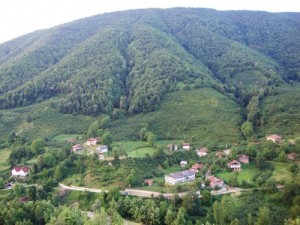 Igdir is historically and culturally significant to the Armenians as the location of Mount Ararat, several Urartian rock monuments, and the Caravanserai of Zor, believed to have been built by an Armenian architect named Ashot in either the 13th or 14th century. The historic ruins of the Armenian Church of Zor were also located in this area as well, though, nothing remains of them today. The historic cities of Aralix (now known as Aralık) and Koghb (now known as Tuzluca) are also located in the area.
Igdir is historically and culturally significant to the Armenians as the location of Mount Ararat, several Urartian rock monuments, and the Caravanserai of Zor, believed to have been built by an Armenian architect named Ashot in either the 13th or 14th century. The historic ruins of the Armenian Church of Zor were also located in this area as well, though, nothing remains of them today. The historic cities of Aralix (now known as Aralık) and Koghb (now known as Tuzluca) are also located in the area.
KARS
 Kars is a city in the province with the same name. It was a onetime Bagratid capital of one of the minor branches. Surp Arakelots Cathedral (Holy Apostles) is a beautiful Armenian church that was first turned into a museum, then a mosque. The province was part of the first independent Armenian republic, but was taken by Kemalist Turkish forces in November 1920, at which time massacres of Armenians ensued, and no Armenians were left. Kars is the base for travel to the magnificent ruins of Ani – the medieval capital of Armenia known as the city of 1001 churches and a rival to Constantinople in its time.
Kars is a city in the province with the same name. It was a onetime Bagratid capital of one of the minor branches. Surp Arakelots Cathedral (Holy Apostles) is a beautiful Armenian church that was first turned into a museum, then a mosque. The province was part of the first independent Armenian republic, but was taken by Kemalist Turkish forces in November 1920, at which time massacres of Armenians ensued, and no Armenians were left. Kars is the base for travel to the magnificent ruins of Ani – the medieval capital of Armenia known as the city of 1001 churches and a rival to Constantinople in its time.
ERZERUM
Erzerum was in the heart of Western Armenia. With tens of thousands of Armenians before World War I, the Russians only found about 100 left when they captured the city in 1916. The nearby city of Yerznga (Erzincan, Turkey) was also a large Armenian center. Yerznga was home to famous historical Armenians such as Movses Yerznkatsi,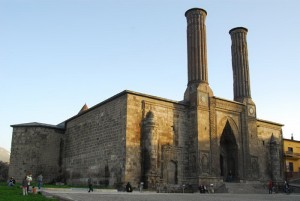 Hovhannes Yerznkatsi and Constantine Yerznkatsi. Yerznkatsi means “from Yerznka” in Armenian.Downstream the Euphrates from Erzerum was Avag Vank (Senior Monastery), a very important cultural center. A little further from the monastery is the Kamakh Gorge, where thousands of Armenians were pushed from the cliffs, into the Euphrates.To the NE of Erzerum is the region of Taik, which also had a Georgian influence and presence. Churches like Oshk and Khakhu are claimed by both Armenians and Georgians as their own.
Hovhannes Yerznkatsi and Constantine Yerznkatsi. Yerznkatsi means “from Yerznka” in Armenian.Downstream the Euphrates from Erzerum was Avag Vank (Senior Monastery), a very important cultural center. A little further from the monastery is the Kamakh Gorge, where thousands of Armenians were pushed from the cliffs, into the Euphrates.To the NE of Erzerum is the region of Taik, which also had a Georgian influence and presence. Churches like Oshk and Khakhu are claimed by both Armenians and Georgians as their own.
DIYABEKIR
Diyabekir is near where the city of Dikranagerd was built by King Tigran the Great in the first century BC, as his capital city. The invading Romans destroyed it in his lifetime, but Armenians associate Diyabekir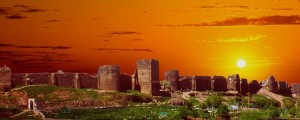 with Digranagerd, and sometimes call it that. The city is now the heart of the Kurdistan region of Turkey. There are a few semi-ruined Armenian Churches in Diyabekir. One dilapidated church was occasionally used for services when a priest from Istanbul was occasionally sent to visit the handful of remaining Armenians up to the 1970s.
with Digranagerd, and sometimes call it that. The city is now the heart of the Kurdistan region of Turkey. There are a few semi-ruined Armenian Churches in Diyabekir. One dilapidated church was occasionally used for services when a priest from Istanbul was occasionally sent to visit the handful of remaining Armenians up to the 1970s.
Kharberd was wiped off the map in 1915. In 1878 the famous “Armenia College” had been established there by American missionaries. Turkish authorities were not happy with this and 10 years later it was renamed the “Euphrates College”.
Malatya is where Polyeuctus, a Christian Armenian, was martyred in the IIIrd century AD. He was later immortalized by Corneille’s writing and Donizetti’s music.
Cappadocia was once the site of an Armenian popula tion, churches and fiefdoms. There are still photographs of the important Armenian churches of Tomarza, Talas, and the fortified monastery of Surb Karapet – which was a site for pilgrammage for Armenians from Gessaria. The church of St. Gregory the Illuminator in Cappadocia still attracted a few remaining Armenians from the area until recently.
tion, churches and fiefdoms. There are still photographs of the important Armenian churches of Tomarza, Talas, and the fortified monastery of Surb Karapet – which was a site for pilgrammage for Armenians from Gessaria. The church of St. Gregory the Illuminator in Cappadocia still attracted a few remaining Armenians from the area until recently.
Human history has seen many losses, many more injustices. Undoubtedly one of the greatest ones of all has been the destruction and loss of epically historic and precious civilization, which thrived for over 4000 years in Armenia’s heartland western territories, Western Armenia called eastern Turkey today.

